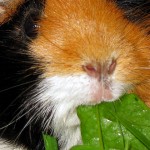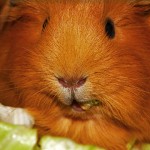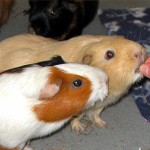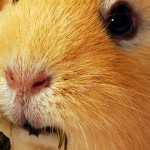What do Guinea Pigs like to eat?
Hay, vegetables, fruits, branches, herbs and other plant. There is very much you can feed your Guinea Pigs. Cavies listen to their natural instinct and really like to eat what grows on ground – raw. Most of all feed hay! This has to be provided permanent. You do your best to your cavies if you provide fresh picked grass too (please no lawn cuttings!). That is way cheaper than any colorful package of junk food from the pet shop and much more healthy as well. Leave the pet shop food untouched (have a look to the dry food / pellets article)!
Fresh Grass is a great seasonal food for their diet from spring to fall but you have to pay attention if you start to feed grass each year. Start with short amount of it and increase every day a bit. This guarantees that cavies will be softly get into the way of it. At winter season you should replace grass with fresh vegetables to keep them healthy with a diet rich in vitamins. Fruits should be always handled like candy and should not be provided that much. Herbs can be provided fresh or dried permanent in any quantity.
A special highlight for Guinea Pigs are these pants who are outside their accessible area. Small branched from trees and leaves are really liked. But do not aimless cut branches from trees in the wood.
Vegetables for Guinea Pigs
Vegetables should be the main fresh food in their nutrition plan at the winter season if/and there is no way to get fresh grass. Of course vegetables does not replace hay. Fresh hay has to be provided permanent. All green marked vegetables can be used for proper diet.
| Vegetable | Hints / notes |
|---|---|
| Aubergine / eggplant | Only the fit without the green. |
| Asparagus | Highly diuretic, feed rarely. |
| Beetroot | Feed carefully because of it oxialic acid. May take color on urine and feces. Can be provided with the green. |
| Broccoli | High amount of vitamin C. Contains oxialic acid. Provide it increasing. |
| Carrot | Rich in calories. Do not feed every da. Can be provided with the green. May take color on urine. |
| Celery | Can be provided complete. Peel if it is root celery. |
| Chicory | Not the outer leaves because of its high amount of oxialic acid. |
| Chinese cabbage | |
| Corn | Only the green! |
| Cucumber | Very popular food for cavies. |
| Endive | rich in vitamins and minerals / appetizing |
| Fennel | rich in vitamins and minerals. Can take on color on urine. Helpful by digestive complaints |
| field salad | Feed carefully in small amounts because of its nitrate (This can cause flatulence and diarrhea) |
| Frisee | |
| Green oats | |
| iceberg lettuce | Only small amounts because of its nitrate (This can cause flatulence and diarrhea) |
| Kohlrabi | Provide it increasing and rarely |
| Lettuce | Provide rarly because of its nitrate (can cause flatulence and diarrhea) |
| Lollo BiancoLollo BiondaLollo Rosso | |
| Mangel / mangold | Contains oxialic acid. Provide it rarely |
| Paprika | Provide without stalk and oly ripe. Rich in vitamin C |
| parsley root | |
| Parsnip | |
| Pumpkin | Decorative gourds are no food! |
| Radicchio | |
| Radish | Only feed the green! |
| red oak leaf lettuce | |
| Rocket | Feed rarely. Contains the ethereous mustard seed oil. |
| Rutabaga | Very good food for winter season. Rich in vitamins. |
| Spinach | Because of its oxialic acid you sould provide it rarely |
| Sunchoke | Entire plant can be provided |
| Swede / rutabaga | |
| Sweet potato / yam / kumera | Rich in sugar and starch. Feed rarely. Can be provided with peel. |
| Tomato | Contains acid. Feed rarely. |
| Turnip | |
| Turnip greens | Rich in vitamin C |
| Zucchini / Courgette | Not liked by all Guinea Pigs |
Fruits for Guinea Pigs
Fruits should be handled as sweets for cavies and not to be provided too much (may be once a week) because of its fructose and fruit acids.
| Fruit | Hints / notes |
|---|---|
| Apple | Do not feed if one of your cavies has lip grind. |
| Banana | Rich in sugar. Do not feed if one of your cavies has Diabetes. Can cause constipation. |
| Grape | Provide rarely and without nubs |
| Kiwi | Fruit acids irritate mouth. Feed rarely. |
| Mandarin | Fruit acids irritate mouth. Feed rarely. |
| Melon | Rich in sugar. |
| Orange | Fruit acids irritate mouth. Feed rarely. |
| Pear | Rich in sugar. Do not feed if one of your cavies has Diabetes. Can cause diarrhea. |
| Rose hip | Can be provided fresh or parched. Rich in vitamin C |
| Strawberry | Can be provided with the green. |
Herbs for Guinea Pigs
Fresh herbs can be provided without limitation. Dry herbs might be provided only a handful once a week cause the cavies run in trouble clearing their water balance otherwise. All herbs can be provided fresh or dried.
| Herb | Hints / notes |
|---|---|
| Blackgrass / slender meadow foxtail | |
| Aaron’s beard / rose of Sharon | Helps against anorexia and wound healing. |
| Alfalfa | Only fresh |
| Arnica / leopard’s bane | |
| Balm | Helps against digestive complaints |
| Basil / sweet / common | |
| Bramble / blackberry bush | |
| Broardleaf plantain / waybread | |
| Buckhorn plaintain | Can attenuate cold |
| Caraway | |
| Chamomile / camomile | Helps against digestive complaints, anti-inflammatory. |
| Chickweed | |
| Clary, sage, salvia | Only provide small amounts |
| Coltsfoot / foalfoot / coughwort | |
| Common borage | |
| Coriander | anticonvulsant, appetizing |
| Corn stalk | without the grain |
| Currant bush | |
| Curry plant | Provide rarely and just a little |
| Dandelion / hawkbit | diuretic & appetizing |
| Dill | appetizing, diurectic, stimulate milkflow |
| Echinacea | build up resistance, to feed only healthy cavies |
| Gallant soldier | |
| Golliwog | Potted plant which can be provided |
| Goosefoot | |
| Goutweed | |
| Gowan / annual daisy / fleabane | |
| Grass | Provide only fresh picked. Can be provided massive |
| Holy thistle / milk thistle | |
| Lamium / Dead-nettle | |
| Lavender | |
| Lemon mint | |
| Lovage | anticonvulsant & diuretic |
| Marygold blossom | |
| Melissa / balm | anticonvulsant & diuretic |
| Mint / spearmint | Not for breastfeed cavies. |
| Mugwort / wormwood | |
| Nettle | Provide dried only. Rich in vitamin C. Diurectic |
| Oregano | |
| Origan / majoram | |
| Parsley | not for breastfeed cavies. Only small amounts to pregnant Guinea Pigs. Take effekt on birth inducing |
| Peppermint | anticonvulsant, Not for breastfeed cavies. |
| Raspberry bush / cane | |
| Rosemary | |
| Shepherd’s purse | |
| Sorrel | |
| Sunflower | only the plant without the leaf and pits |
| Tarragon | Appetizing |
| Thyme | provide by respiratory infection |
| Valerian root | |
| Yarrow / milfoil | appetizing, helpful by cystitis or kidney disease |
Branches and leaves
| Tree / brances | Hints / notes |
|---|---|
| Alder | Provide in small amounts only |
| Apple | Can be provided in lage amounts |
| Beech, european beech | Provide in small amounts only. Rich in oxialic acid |
| Birch | Rich in tannic acid. Provide rarely |
| Cherry | |
| Currant | Can be provided in lage amounts |
| Fir | Provide rarely. Not really liked by all Guinea Pigs. |
| Hazelnut | Can be provided in lage amounts |
| Lime | |
| Maple | Feed rarely |
| Pear | Can be provided in lage amounts |
| Pine | Provide rarely. Not really liked by all Guinea Pigs. |
| Plum | |
| Spruce | Provide rarely. Not really liked by all Guinea Pigs. |
| Willow, corkscrew willow |
Feeding planner / Scheduler for Guinea Pigs
| time | Notes |
|---|---|
| in the morning | large amount of hey, provide first fresh food |
| at noon | provide the second meal of fresh food |
| at afternoon | provide the third meal of fresh food / may be some fruits |
| in the evening | provide the last meal of fresh food |
| Fresh hay has to be provided all time. Water has to be filled up from time to time. Only use clear and fresh water. There is no reason to provide special “rodent-water” from the pet shop if you take care about the food for your Guinea Pigs. Fresh food are always undried vegetables or fresh picked grass which is natural rich in water. You should provide at least 10% fresh food of its Cavys own weight each day. Fruits should only be provided once a week due to its fruit acids and fructose. | |







